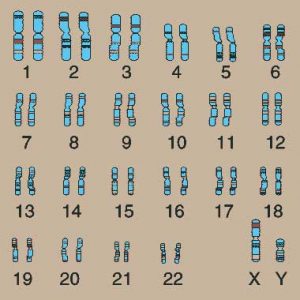chromosomes
 Before DNA was discovered, scientists had already identified chromosomes within each human cell. These were observed under a normal microscope after colouring the cell (chromos means colour). So now we know that chromosomes are really long pieces of DNA, each containing between 500 and 1000 genes.
Before DNA was discovered, scientists had already identified chromosomes within each human cell. These were observed under a normal microscope after colouring the cell (chromos means colour). So now we know that chromosomes are really long pieces of DNA, each containing between 500 and 1000 genes.
Each human body cell contains 46, that is 23 pairs, of chromosomes. This is typical of our species. Other species have different numbers. The only cells in our body that have a single set of 23 chromosomes are sperm cells and egg cells. When they come together at conception, the 23 chromosomes of each are joined. In this way the new individual receives a full set of 46 chromosomes, but from two different parents.
X & Y chromosomes
As explained earlier, every human cell contains 23 pairs of identical chromosomes. One of the 23 pairs is called ‘sex chromosomes’. In the female this pair consists of two so-called X chromosomes (they have the shape of an X). So in a female all the 23 pairs of chromosomes are identical, including the sex chromosome pair XX. In males, the sex chromosome pair is not identical: it consists of an X, just like in the female, and an Y chromosome (which has the shape of an Y and is much larger than the X chromosome).
Thus males and females differ genetically: females have among their 23 pairs of chromosomes an XX pair, males have an XY pair). The difference is created at the moment of conception, when egg meets sperm. It is the sperm cell that determines what sex the new individual will have. The reason is as follows:
Remember that sperm and egg cells have 23 single chromosomes. The egg cells all have an X chromosome, but sperm cells have either an X or an Y chromosome. If, at the moment of conception, the sperm cell that penetrates the egg contains an X chromosome, which couples with the X of the egg, the result will be a female pair (XX). If it contains a Y chromosome it will combine with the X of the egg to make a male (XY).
